Microsoft BUILD: Windows 8, A Pre-Beta Preview
by Brian Klug & Ryan Smith on September 13, 2011 12:05 PM EST- Posted in
- BUILD
- Windows
- Microsoft
- Windows 8
- Trade Shows
The Technical Side Of Windows 8: Cont
Moving up the chain, Microsoft has added a number of base class drivers for hardware in Windows 8. This includes not only USB 3, but also class drivers for mobile broadband radios, sensors, and even printers. For printers this means Windows 8 can print to roughly 70% of all Windows 7 certified printers without an additional driver, which is nearly a necessity for Windows 8 as an ARM tablet OS, as drivers may not be available and tracking down a driver flies in the face of the modern pre-configured OS model for tablets.
For mobile broadband things are a bit more interesting. With this addition mobile broadband is being promoted to a first class connectivity option, right up there with Wi-Fi and Ethernet. Mobile broadband hardware can then be integrated into a laptop or a tablet or added via a dongle without requiring a driver or a complex dialer/manager application. Managers will still exist in a lesser form as a Metro application; Microsoft included one such example with the tablet we tested, which had a working AT&T 3G modem and its associated management application.

Windows 8 will also be aware of the limitations of mobile broadband connections, with an emphasis in usage caps. Given appropriate information by the ISP Windows 8 knows to halt background download processes (e.g. Windows Update, weather updates, RSS) to keep them from consuming valuable bits, and to notify the user if the device is approaching the cap and would be subject to overages. Along these lines Windows 8 also knows to switch to another source (i.e. Wi-Fi) when it’s available to avoid using up those metered bits.
We’ve mentioned permissions before when talking about the Windows Store, but it seems prudent to mention it again. For Metro applications Windows 8 will have a more fine grained permissions model than existing low/user/admin level privileges, by implementing Android style permissions. Metro applications will only be able to access the resources and data they were approved for, reducing the ability for a compromised application to be used as a launch pad for further attacks.
Our next stop on our look at the technical details for Windows 8 is the boot process. Microsoft put up an interesting blog last week discussing Windows 8’s new boot process, which was reiterated here – Windows 8 boots up much faster than Windows 7 thanks to the fact that only user processes are shut down, meanwhile the kernel is hibernated rather than shut down, shaving off a lot of time that would be needed to reload the kernel from a fresh boot. Realistically you need a motherboard with a very fast POSTing sequence, which means this is best paired with UEFI-based OEM boards. Certainly self-built systems will improve too, but we would not expect by as much.
The other new fact discussed about the Windows 8 boot process was that Microsoft is making another push to secure it through chain of trust hardware (presumably a TPM module), this time under the name Secure Boot. Utilizing the chain when available, if Windows 8 detects that a boot component has been modified it will fail the boot and kick over to the Windows Recovery Environment to restore the OS to a fixed state. With ARM devices (and even most PC tablets) the use of this feature will be a given, but obviously TPM hardware is much rarer on laptops and desktops.
Windows’ anti-malware features will also be making an appearance in the boot process. Windows Defender (which now includes Microsoft Security Essentials) now loads immediately after the critical boot components are loaded, allowing Defender to check everything that wasn’t protected by the Secure Boot process above.
Finally when it comes to booting, the last bastion of the CLI in the Windows boot process is gone. The F8 menu has been replaced with a GUI based Windows Recovery Environment. The WRE goes hand in hand with two other recovery features: Refresh and Reset.
Reset is a Windows-based implementation of OEM OS recovery partitions: when Reset is triggered, the entire system is overwritten by the restoration copy. As for Refresh it’s a bit more nebulous; it’s apparently a new implementation of Windows’ existing Last Known Good Configuration, allowing users to revert anything crapware may have done. But we don’t have the full details on its underpinnings at this time.

Last, but certainly not least we have the Task Manager. Other than a couple of minor changes with Windows Vista the Task Manager has remained nearly unchanged for years, so of course Microsoft has gone ahead and overhauled it. By default the new Task Manager is extremely simplified and only lists running user applications, thereby ensuring users only close applications and not background processes and such by mistake.
In detailed most the Task Manager takes on a more traditional appearance, giving you greater details about all of the running processes (including breaking them down by application or background process), but also a number of new performance metrics (largely taken from Windows 7’s performance monitor), and even an over-time breakdown of the resource usage of all of the system’s installed Metro applications. Interestingly the Task Manager itself is not strictly Metro, but rather a desktop application that doesn’t require the desktop environment to be loaded.


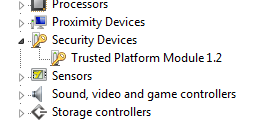
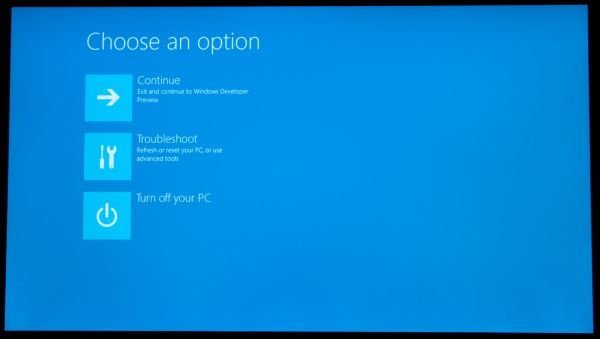
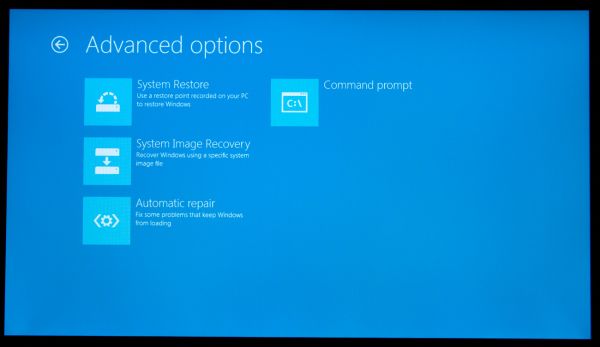
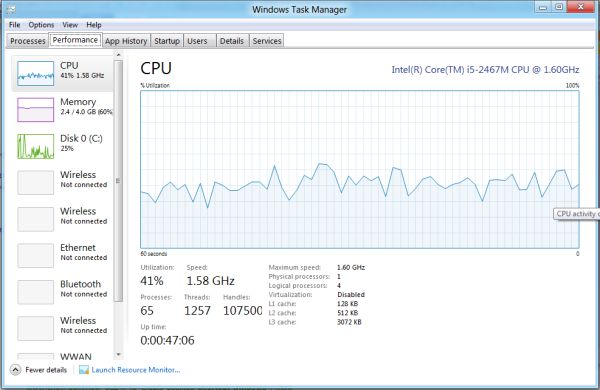
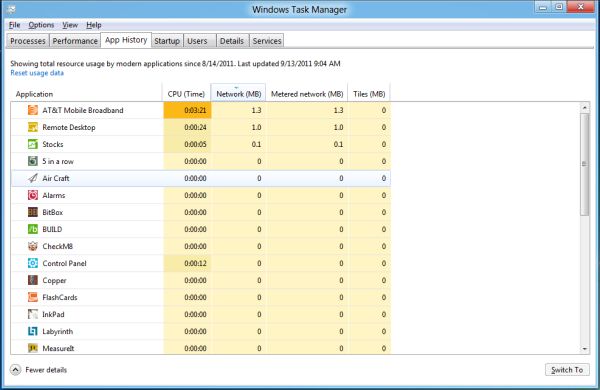








235 Comments
View All Comments
Zan Lynx - Wednesday, September 14, 2011 - link
Interesting isn't it, that Microsoft has made versions of Server 2008 that don't have a desktop.I haven't run a server with a GUI in the last 12 years. Who would?
Text file based configuration that can be remotely managed, programmed and monitored entirely by script...
Using a GUI to point and click is horribly inefficient and doesn't scale to more than two servers.
Real sysadmins don't do pretty. They want it to work. Real sysadmins don't spend time clicking GUI buttons configuring new machines. They boot them and they auto-configure from the network. You never touch a GUI. Just the power button.
You might use a GUI to configure one user as a template in Active Directory. You'd never use the GUI to add 100 new employees to the system.
The real use for the GUI is to distract the management while you get real work done behind the scenes using a laptop and an SSH command line.
A GUI for tiling your command windows might be acceptable. Barely.
smithg5 - Wednesday, September 14, 2011 - link
My point wasn't that all sysadmins use GUIs now, but that the GUI hasn't gotten in the way of sysadmin work on a command-line, even though in most cases for Windows it starts up with the computer. This is a useful analogy for all these fears about Metro in a business environment.That said, most of the volume Microsoft sees for Windows server is that "two servers" size environment. Most businesses don't even have 100 employees. For the rest you'll still have your desktop, and that desktop will still have a command-line interface. And hey, they might even make desktop-less, Metro-less versions for the enterprise. If they don't, it won't somehow make your text-file configuration, CLI remote administration wizardry stop working. You'll just be a couple of clicks from that when you start up your server/laptop, and then you'll have something pretty to look at during your breaks. Those servers that you never see the desktop of will benefit from a smaller memory footprint. What's the problem?
piroroadkill - Thursday, September 15, 2011 - link
No, not really. For the vast majority, the gui represented a way to use a computer that made sense to more people.Metro is just a kind of gui, but heavily designed around touch and full screen tablet style use.
It's simply a bad fit for desktop users. I tried the dev preview, and I'm not impressed in the slightest.
This time, it isn't about resisting change for the sake of it. Really. The dev preview is seriously quite bad. Keyboard and mouse wise, it just sucks.
TEAMSWITCHER - Wednesday, September 14, 2011 - link
I've got the Developer Preview Up and running on a machine and I must say that I absolutely hate it! Whenever I click on the Windows Start Icon (lower left corner) you go to the Start Screen (METRO GUI), the Start Menu is gone! That's just not cool. Also the full screen metro apps are real easy to get lost in, it's begging for some kind of Mac OS X like Mission Control to see all running processes. There is no Back Button, I have to hit the Windows key to get back to the Start Screen. The Desktop (which has been standard on every Windows machine since the dawn of time) is now a strange bolt-on appendage to the METRO GUI experience. I don't know...this isn't beta yet and things may change....but so far consider me one totally pissed off Windows user...this shit isn't Windows. Feels more like Vista meets Bob. Oh, and calling icons "Charms" is gay.UMADBRO - Wednesday, September 14, 2011 - link
Well, at least you tried it. But try and remember, this is still a pre-beta, and isnt finished yet.Icehawk - Wednesday, September 14, 2011 - link
What are they trying to achieve? If it is one OS to rule them all I think they are making some serious mistakes as I do not believe traditional computing will be dominated by cellphones or tablets, they serve a much different function and will continue to do so indefinitely IMO. The apparent dumbing down of the OS to mimic a smartphone seems like a terrible idea to me.*Assuming* the desktop/Metro experience isn't radically altered the paradigm shift to right-hand panes (ie, the "charms" menu) makes no sense, for the last 10-15 years we've worked from the left. Works fine if I'm using a tablet but that is it - on a desktop nothing could be more jarring. Especially when it isn't uniform, for example the Start menu still pops up on the left. Ugg.
Also why does anyone think I want a touchscreen on my desktop? How am I supposed to reach it my arms are not 3' long! I guess we'll be forced at the least to use multi-touch pads? I hope it will work in tandem with a mouse since I'm not sure how the hell I'd game using a touchpad.
Shinya - Wednesday, September 14, 2011 - link
Microsoft,I really dont care for Ubuntu (lack of support and games) and OSX (lack of games, software, etc etc)
Please don't make me switch.
give us the ability to turn off Metro when it releases
ct82fl - Wednesday, September 14, 2011 - link
I think if Microsoft really wants to succeed in the tablet market with their OS, they really need to figure out a new innovative way to navigate. I saw very similar things to Apple's OS and iOS. In order to beat the competition they are going to need to figure this out and figure it quickly.cyberguyz - Wednesday, September 14, 2011 - link
Sorry but I am a power user of my computers. I don't want them looking or working like a tablet or my iPod.While I am usually on the bleeding edge with Windows, from beta onward with each release, this is one I am most definitely sitting out. It does not appeal to the way I want to use my computer at all. For a tablet that I am not expecting to use for heavy input or output, Win8 is just too cumbersome and tied to mouse or touch as primary inputs.
Rand - Wednesday, September 14, 2011 - link
A few suggestions, make CERTAIN your applications all have different names. If your applications have an uninstall.exe they will all be grouped together on the start screen with no way to differentiate them or tell which is for what program.Similarly, if your apps have a config.exe you won't be able to tell which is for which without opening them individually. Any executables must have clearly differentiated names that indicate precisely what they are.
Also, you absolutely must trim down your bookmarks to only a handful. If you're accustomed to having a 100-200 bookmarks in various folders in your browser, that isn't going to work well at all in Windows 8. You'll end up with screen after screen after screen of bookmarks.
I don't think it's remotely practical or usable any longer to have more then a dozen bookmarks at the most.